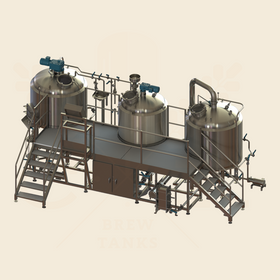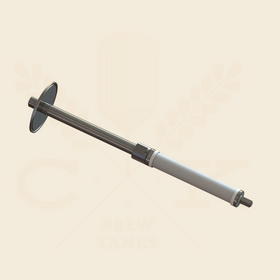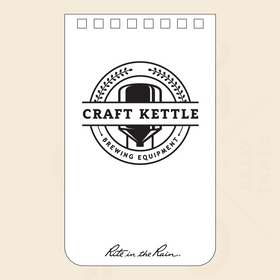
Boiling
As the brew day progresses along, eventually the boil kettle will be filled with high quality wort containing few solids (hopefully). If the brewer isn’t distracted and timed it properly, the boil should start shortly after finishing the lauter. While a home brewer may see the boil as an opportunity to crack open a cold one and occasionally toss hops in the kettle, a commercial brewer likely has a lot on his or her plate. Whether sipping on a beer or scrambling to get ready for the next step, brewers should know what is chemically, biologically, and physically happening to the wort during the boil.
A vigorous, rolling display of wort in the kettle signals the start of the boil. The wort moves in a convective, or circular motion, as it continually heats up and cools back down inside the kettle (see picture 1). The adjective vigorous is imperatively used when describing a proper wort boil, as there are potential negative side effects to boiling at a lower rate. So crank up the heat…but carefully of course.

Boils are typically no shorter than 60 minutes, for reasons we will discuss. There are many potential boil additions the brewer needs to consider before starting, the obvious additions being hops. Most brewers time the boil by starting a 60 minute stopwatch and counting down. Hop additions on recipes are typically labeled with this stopwatch in mind. For instance, if boiling for an hour, a “60 minute addition” means hops are added at the beginning of the boil. Likewise, a “10 minute addition” means they get added 50 minutes into the boil, or with 10 minutes remaining.
It has been known for quite some time that adding hops has an enormous impact on flavor and bitterness in beer. What also was known by centuries old brewers is that when the hops were added to the boil, how many were added, and the variety of hops used, also greatly impacted the flavor and bitterness of the wort and end beer. Home brewers likely have a good grasp on hops commonly used such as; Cascade, Chinook, Citra, El Dorado, Saaz, Magnum, Mosaic…okay you get the picture. The point is, there are many, many hop varieties, all of which are unique, and bring different flavor and bitterness attributes to the end beer.
Of the many measured analytical compounds in hops, the α-acid percentage is of particular importance to the brewer. This percentage (commonly listed on the hop certificate of analysis), allows the brewer to calculate isomerized bitterness units (IBU’s) in the wort. Calculate?…uh oh. Yes, calculate; fortunately (or maybe unfortunately) many other formulas are available and can be used for wort production, allowing for continued consistency and quality. The IBU formula allows the brewer to estimate the bittering effect isomerized, or soluble α-acids have on the wort.
The time the hops are added to the boil, the temperature of the wort, the amount and variety of hops added, and the wort gravity all affect the hop utilization percentage. This percentage allows brewers to calculate the approximate IBU’s obtained per hop addition. All of the hop addition IBU’s can then be added to calculate the total IBU content of the wort.
IBU information is typically included on the beer’s package, and is generally recognized by most craft consumers. While some breweries have capabilities to run analytical tests on the true IBU content of a beer, it is important to remember that many craft breweries rely on these formulas which calculate an approximation. The reality is that the brewing industry is currently lacking research regarding perceived bitterness versus measured bitterness.
While the addition of hops is undoubtedly altering the flavor and chemistry of the wort, the boil itself also has an enormous impact. High heat, plus amino acids, and the sugary wort combine to create melanoidin compounds. This flavorful, “browning” chemical reaction is known as the Maillard Reaction, which is likely common in your everyday culinary life; searing steak, baking bread, or in the roasted coffee you buy. The sugary wort is also subjected to carmelization reactions at higher temperatures. These reactions are examples of the immense flavor changes taking place in the boil.
Aside from flavor, melanoidins and caramel compounds additionally affect the color of the wort. Increased amounts of both work together to make the overall wort color darker, or increased. As the wort gets darker the longer it boils, the pH of the wort also changes. Both melanoidins and hop acids work to slightly decrease the wort pH in the boil.
While we are creating desirable flavor compounds, we are also evaporating off undesirable ones. Have you ever had a beer that tasted like creamed or cooked corn? Hopefully not, but if so, this could be a sign of a low intensity or shorter duration boil. The compound responsible for this, known as Dimethyl Sulfide (DMS), is largely influenced in the malting process. It is a volatile compound that has more potential to develop in recipes using higher percentages of lightly kilned malts (Ie; Pilsner malt). Although other volatile off-flavors exist, brewers are mostly familiar with DMS, and may correspondingly increase the boil time or rate to account for potentially DMS-prone recipes.
The formation of higher molecular weight proteins is also desirable at this point in the process. Higher temperatures allow for proteins derived from the malt, to bond with other compounds (polyphenols). This bonding creates a heavier molecule, which makes these proteins better at sinking to the bottom of the kettle. Making them ‘sinkable’ allows for easier removal, and has beneficial impacts on flavor and cellar processing. This formation of proteins is referred to as protein coagulation, and may even be aided by a processing aid known as Irish moss (see picture 2). Irish moss (typically a “10 or 15 minute boil addition”) is derived from algae, and has a negative molecular charge which attaches to these positively charged proteins, allowing them to sink, and be more easily removed.

We’ve covered chemical changes in the boil to this point, so let’s switch gears and look at what is happening biologically. As brewers, we typically want one culture of organisms eating and digesting our meticulously designed and crafted wort; that organism is yeast. By boiling for at least an hour, we are effectively killing greater than 99% of any organisms present in the wort. This convenient microbial destruction allows us to greatly favor (in the fermentation process) the alcohol and CO2 creating organism we know and love. A greater than 99% reduction in microbes is known as sanitizing, or disinfecting.
Physically, aside from the color changing due to increased melanoidins, the volume level of the wort is decreasing as we continue boiling. As the water evaporates (sending unwanted volatile compounds with it) our wort gradually becomes more condensed. A system’s evaporation rate is typically known by brewers, and corresponds with an increase in wort density or gravity as the wort condenses. Some brewers may even brew “higher strength” wort, knowing that they will add water back into the kettle after boiling, to hit their target gravities; this is one example of high gravity brewing.
Although the level of the wort decreases during the boil, there may be times where it seems like it is increasing. By this, I mean where wort is physically spilling out of the kettle. An event like this is known as a “boil over” and is problematic for several reasons. First is safety; scolding hot wort and skin make for a nasty combination. Hop additions are often the culprit of these boil overs, as adding solids disrupts nucleation sites within the boil, often causing it to “foam over”.
For safety purposes, turning the heat off of the kettle during hop additions may be necessary. Always wear proper protective equipment (some breweries may even require brewers to wear their pant legs over brewing boots to prevent boiling wort from being dumped into the brewer’s boots). Consider having adequate headspace in the kettle or using an anti-foaming agent. Anti-foam boil additives are used to decrease foam build up in the kettle (note that they may require filtering out in the cellaring process if silica based). As a last resort for controlling a boil over, at a safe distance, spray cold water on to the foam as this will help knock it back down.
Other than the safety aspect, a boil over can obviously impact the volume of wort in the kettle. This can translate to inaccurate hop utilization or gravity calculations, resulting in a different wort than originally designed. Boil overs are messy and are arguably equivalent to sending money down the drain; be aware of them and follow the steps above to prevent them.
Whew…chemical, biological, and physical changes, all in one process! To summarize; from the beginning of the boil to the end; wort bitterness will increase (more IBU’s as hops are added), wort flavor will increase (thank you yummy hop, melanoidin, and caramel compounds), wort color will increase (darken), pH will slightly decrease, volatile off-flavors will decrease, proteins will coagulate (making them easier to remove), any microorganisms present will be destroyed (well, 99.999…% will be destroyed), wort gravity will increase, and your craving for a shift beer will surely increase.
Happy brewing.
Photo References:
Convection boiling photo:
https://www.ck12.org/physics/convection/lesson/Convection-MS-PS/
Irish moss photo:
https://blog.khymos.org/2011/10/26/wonders-of-extraction-brewing-beer/




